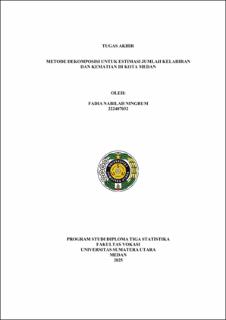Metode Dekomposisi untuk Estimasi Jumlah Kelahiran dan Kematian di Kota Medan
Decomposition Method for Estimating Births and Deaths in Medan City

Date
2025-07Author
Ningrum, Fadia Nabilah
Advisor(s)
Hasibuan, Citra Dewi
Metadata
Show full item recordAbstract
Background: The population dynamics of Medan City during the 2014–2024 period show significant changes in birth and death patterns, especially post-COVID-19 pandemic. Comprehensive analysis is needed to identify long-term trends, seasonal patterns, and driving factors to support data-driven policy planning.
Objective: To analyze the temporal structure of births and deaths by separating trend, seasonal, and random components using time series decomposition methods.
Methods: Time series decomposition (additive and multiplicative models) using IBM SPSS Statistics software.
Results:Births: Significant decreasing trend (slope = -1852.54/year) during 2015–2021 (e.g., August 2014 = 5,530.6 → August 2015 = 3,678.1), followed by a 2.1% increase post-2022. Seasonal pattern peaks every January–March (+15–18% vs. annual average). Deaths: Stable trend (slope = +0.21/year) with a 34% surge during the pandemic (2020–2021). Seasonality: consistent increase June–December (peak in August +22%). Random Component: Irregular fluctuations related to COVID-19 (e.g., April 2014 = +1,953.2; July 2014 = -711.2).
Conclusion: The decomposition method effectively revealed the temporal structure of Medan's demographic data. The sharp decline in birth trends (-1852.54/year) necessitates immediate reproductive health policy interventions, while the seasonal death pattern serves as a reference for health resource allocation.
Keywords: Time series decomposition, births, deaths, demographic trends, Medan City.
Collections
- Diploma Papers [191]
